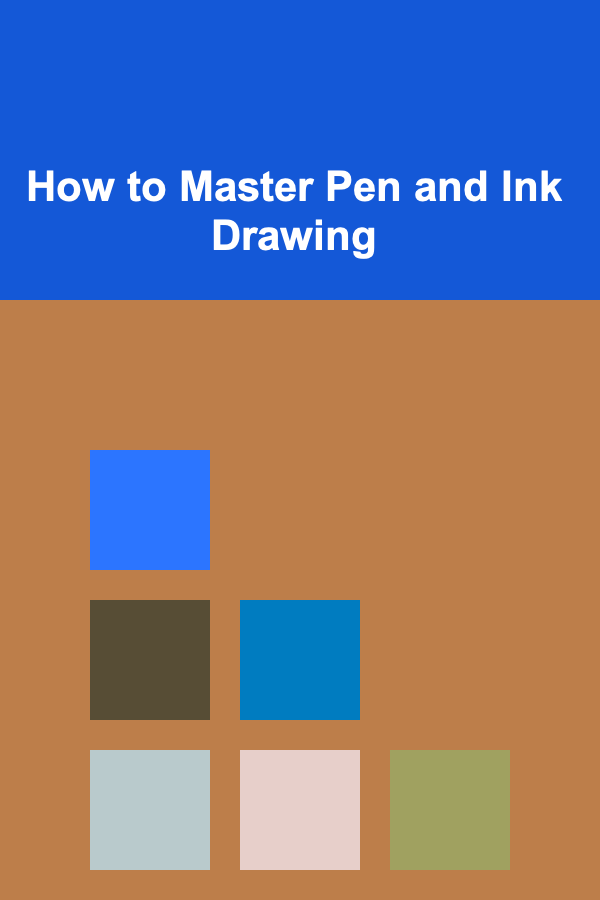
How to Master Pen and Ink Drawing
ebook include PDF & Audio bundle (Micro Guide)
$12.99$6.99
Limited Time Offer! Order within the next:

Pen and ink drawing is one of the most classical forms of art, dating back centuries and continuing to captivate artists and audiences alike. The intricate details, sharp contrasts, and delicate line work that define this style create a unique visual experience, making it both challenging and rewarding to master. This article delves into the techniques, tools, and approaches you need to understand to truly excel in pen and ink drawing.
The Beauty of Pen and Ink
Pen and ink drawings are often known for their precision, depth, and striking contrasts. With just a pen, ink, and paper, artists can create everything from fine, detailed illustrations to bold, graphic artworks. What makes this medium so compelling is its versatility. Pen and ink drawings can range from highly detailed, realistic renderings to abstract and expressive compositions. This diversity in outcomes can be attributed to the various techniques that can be applied to ink drawings, each offering a different aesthetic.
One of the unique aspects of pen and ink drawing is the reliance on lines. Unlike painting or other mediums where color can be used to add depth and texture, pen and ink relies on the careful placement of lines, dots, and hatching to create the illusion of light, shadow, and texture. This requires not only technical skill but also a keen understanding of how lines can convey form and emotion.
Historical Significance of Pen and Ink
Pen and ink have a long history in the world of art, especially in the realms of illustration and design. In the Renaissance, artists like Albrecht Dürer and Leonardo da Vinci used ink to create detailed studies of human anatomy, architecture, and nature. This tradition of using pen and ink to document and interpret the world has persisted through the ages, with artists continuing to push the boundaries of this medium.
In the 19th and 20th centuries, pen and ink became a popular tool for comic book artists, illustrators, and graphic designers. Artists like Hergé, the creator of Tintin , and Frank Miller, known for Sin City, used pen and ink to create bold, dynamic images that have had a lasting impact on modern visual storytelling.
The Tools of the Trade
Before diving into techniques and tips for mastering pen and ink drawing, it's important to understand the basic tools you'll be working with. While pen and ink drawing may seem like a simple medium, the right tools can make all the difference in your results.
Pens
There are several types of pens that artists commonly use in pen and ink drawing:
- Fountain Pens: These are traditional pens that use ink cartridges or converters filled with liquid ink. They offer a wide range of line widths and can be used for both fine, detailed work and broader strokes.
- Technical Pens: Often used for precision, technical pens come with a fine, consistent nib and are perfect for detailed drawings. Brands like Micron and Staedtler make technical pens that are a staple for many pen and ink artists.
- Dip Pens: These pens require you to dip the nib into an ink bottle. Dip pens are preferred for more expressive, fluid line work. They offer more flexibility in terms of line variation, making them a favorite for calligraphy and sketching.
- Brush Pens: A hybrid between a pen and a paintbrush, brush pens have flexible tips that allow for varied line thickness. These are great for artists who want to combine the control of a pen with the fluidity of a brush.
Ink
The type of ink you use can also impact your drawing. There are two main types of ink:
- India Ink: This is a high-quality, waterproof ink that produces deep, rich blacks. It's a popular choice for pen and ink artists due to its permanence and smooth flow.
- Carbon Ink: This ink is similar to India ink but has a more intense black color and is less prone to fading over time.
- Colored Inks: While black ink is the most common, artists often use colored inks to add a bit of flair to their drawings. Experimenting with colored inks can open up a new realm of possibilities in pen and ink art.
Paper
The type of paper you use is crucial for achieving smooth, clean lines. Textured paper may cause the pen to catch or skip, which can disrupt the drawing process. Opt for smooth, heavyweight paper that can handle the ink without bleeding. Many artists prefer hot-pressed watercolor paper or Bristol board for their ink drawings.
Techniques in Pen and Ink Drawing
Once you have the tools, it's time to dive into the techniques that will help you master pen and ink drawing. These techniques range from basic to advanced, allowing you to create everything from simple line drawings to highly detailed and dynamic compositions.
Hatching and Cross-Hatching
Hatching is one of the most fundamental techniques in pen and ink drawing. It involves drawing parallel lines to create shading and texture. The closer the lines are to each other, the darker the shading will appear. Cross-hatching takes this a step further by adding another layer of lines perpendicular to the first. This technique allows for more complex shading and a greater range of values in your artwork.
Hatching and cross-hatching can be used in a variety of ways. For instance, they can be employed to depict the texture of a surface, create depth in a figure, or add drama to an illustration. The direction, spacing, and density of your hatch lines can all influence the final effect. Mastery of this technique allows for highly detailed, realistic works or stylized, graphic compositions.
Stippling
Stippling is the process of creating shading and texture by using small, distinct dots. This technique requires patience and precision, as the dots must be placed strategically to create the desired effect. The density of the dots determines the value, with closely spaced dots appearing darker than those spaced farther apart.
Stippling is a great technique for artists who want to achieve a more delicate, subtle effect. It's commonly used in fine art and botanical illustrations where small, intricate details are essential. Stippling can also be used in combination with hatching and cross-hatching to enhance the richness of the drawing.
Line Variation
Line variation refers to the use of lines of different thicknesses and intensities to convey different elements within a drawing. Thicker lines can be used for bold outlines or shadows, while thinner lines can be used for finer details or delicate features.
By varying the pressure on the pen or changing the angle of the nib, artists can create a wide range of line weights. This adds depth and contrast to the drawing, making certain elements stand out while others recede into the background.
Contour Drawing
Contour drawing involves outlining the edges of objects or figures to create a sense of form and volume. The key to successful contour drawing is to follow the natural curves and shapes of the subject, allowing the lines to flow in harmony with the contours of the form. This technique is often used in figure drawing, where capturing the shape and movement of the human body is essential.
A more advanced version of contour drawing is blind contour drawing, where the artist attempts to draw the subject without looking at the paper. This encourages a more direct, observational approach and helps improve hand-eye coordination.
Expressive Mark Making
Pen and ink drawings are not limited to strict lines and shapes. Many artists use pen and ink for expressive, spontaneous mark-making, using quick, gestural strokes to create energy and movement in their work. This approach is often used in abstract art or to convey emotion through the dynamic use of line.
Expressive mark-making is a great way to break free from rigid techniques and explore the fluidity of pen and ink as a medium. It also allows for a more personal and intuitive style of drawing.
Developing Your Style
Mastering pen and ink drawing is about more than just learning techniques; it's also about developing your own unique style. Every artist brings their individual sensibility to the medium, whether through the choice of subject matter, the use of techniques, or the way they approach the drawing process.
To develop your style, spend time experimenting with different techniques and tools. Draw from life, from photographs, and from your imagination. Explore various subjects and see how different styles of pen and ink work with each one. Over time, you'll begin to notice patterns in your work and develop a sense of what feels most natural to you.
Building a Routine
As with any artistic discipline, practice is key to improvement. Developing a routine for pen and ink drawing will help you refine your skills and build confidence in your ability to create detailed, expressive works. Set aside regular time for drawing and focus on specific techniques or challenges you want to tackle.
You might start by focusing on individual elements of your drawings, such as shading or line work, before moving on to complete compositions. With time and consistency, you'll begin to see improvement in your technique and the quality of your work.
Learning from the Masters
One of the best ways to learn pen and ink drawing is by studying the work of master artists. Artists like Rembrandt, Gustave Doré, and more modern illustrators such as Edward Gorey and Bernie Wrightson have created some of the most iconic pen and ink drawings in history. Analyzing their work can give you insight into how they used various techniques and how they approached composition and texture.
Visit museums, study art books, and examine their sketches and drawings up close. Try to replicate their techniques and incorporate what you learn into your own practice.
Conclusion
Mastering pen and ink drawing is a journey that requires patience, practice, and an eye for detail. It's a medium that can seem simple at first, but as you delve deeper, you'll discover the incredible depth and versatility that it offers. By understanding the tools, learning essential techniques, and developing your own unique style, you can elevate your pen and ink drawings to a level of artistry that is both powerful and expressive. Keep drawing, experimenting, and refining your skills, and you'll soon be able to create stunning works of art with nothing more than pen, ink, and paper.
Reading More From Our Other Websites
- [Home Maintenance 101] How to Implement Effective Termite Control Measures
- [Organization Tip 101] How to Create a Wall-mounted Pet Supply Organizer
- [Organization Tip 101] How to Organize Your Garage Tools for Efficiency
- [Personal Investment 101] How to Start Investing in Foreign Exchange (Forex)
- [Personal Care Tips 101] How to Make a Smoothie That's Both Healthy and Delicious
- [Home Maintenance 101] Bathroom Tile Installation: Tips for a Professional Look
- [Paragliding Tip 101] Soaring Above the Clouds: The Best Paragliding Schools in Asia Offering Multi‑Week Intensive Courses
- [Personal Investment 101] The Power of Deep Learning in Affiliate Marketing: Make Passive Income
- [Home Staging 101] How to Home Stage on a Budget: Tips and Tricks for Every Room
- [Organization Tip 101] How to Organize Your Child's Backpack and School Supplies

How to Build a Checklist for Strong Website Password Protection
Read More
How to Create a Functional Entryway with Effective Storage Solutions
Read More
How to Create a Stylish Entryway with Low-Cost Decor
Read More
How to Set Up an Accounting System for Small Businesses: A Detailed Actionable Guide
Read More
How to Master the Art of Networking
Read More
10 Tips for Managing a Daily To-Do List with ADHD
Read MoreOther Products

How to Build a Checklist for Strong Website Password Protection
Read More
How to Create a Functional Entryway with Effective Storage Solutions
Read More
How to Create a Stylish Entryway with Low-Cost Decor
Read More
How to Set Up an Accounting System for Small Businesses: A Detailed Actionable Guide
Read More
How to Master the Art of Networking
Read More